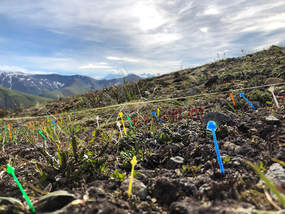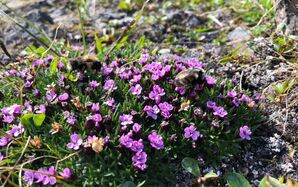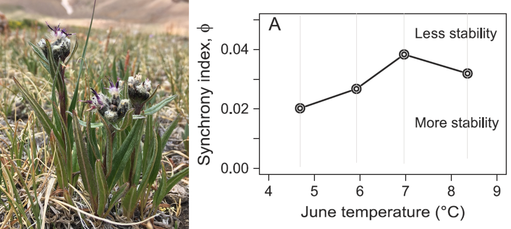Biological diversity is increasingly being shaped by environmental change. We use a combination of experiments, observations, and models to investigate the evolutionary and demographic processes that determine how populations persist and adapt in novel and fluctuating environments.
 Plastic toothpicks in the Wrangell Mountains of Alaska, marking Polygonum tubers transplanted from throughout the species' latitudinal range.
Plastic toothpicks in the Wrangell Mountains of Alaska, marking Polygonum tubers transplanted from throughout the species' latitudinal range.
How does local adaptation drive responses to climate change?
Most populations are locally adapted to a narrower range of environmental conditions than experienced throughout the species range. Theory predicts that local adaptation to historical climate can alter responses to climate change, both in local populations and range-wide. In collaboration with Dr. Dan Doak and Dr. Bill Morris, we are investigating the competing effects of local adaptation and phenotypic plasticity in determining climate change responses for two alpine plants, moss campion (Silene acaulis) and alpine bistort (Polygonum viviparum). By combining long-term demographic data with climate manipulation and common garden experiments, we're testing the effects of local adaptation on predictions of species' distribution and abundance under climate change.
Relevant papers:
Most populations are locally adapted to a narrower range of environmental conditions than experienced throughout the species range. Theory predicts that local adaptation to historical climate can alter responses to climate change, both in local populations and range-wide. In collaboration with Dr. Dan Doak and Dr. Bill Morris, we are investigating the competing effects of local adaptation and phenotypic plasticity in determining climate change responses for two alpine plants, moss campion (Silene acaulis) and alpine bistort (Polygonum viviparum). By combining long-term demographic data with climate manipulation and common garden experiments, we're testing the effects of local adaptation on predictions of species' distribution and abundance under climate change.
Relevant papers:
- DeMarche et al. 2019. Incorporating local adaptation into forecasts of species' distribution and abundance under climate change. Global Change Biology 25:775-793.
- Chardon et al. 2019. Incorporating intraspecific variation into species distribution models improves distribution predictions, but cannot predict species traits for a widespread plant species. Ecography 42:1-15.
- DeMarche et al. 2018. Both life history plasticity and local adaptation will shape range-wide responses to climate warming in the tundra plant Silene acaulis. Global Change Biology 24:1614-1625.
How do populations persist in variable environments?
Natural populations experience fluctuating environmental conditions across space and time. Several projects in the lab explore the range of processes that allow small populations to persist over long time periods in the face of environmental variability. A long-standing observation in flowering plants has been that isolated or ecologically marginal populations often have higher self-fertilization rates (‘Baker’s Law’), suggesting that this could be an important mechanism enabling population persistence. Diverse responses to environmental variation can also act to stabilize ecological systems. Although diversity-stability relationships have been most intensively studied at the community level, with an emphasis on diversity of species or functional groups, individuals within populations can also differ in traits that govern responses to environmental variation. We use a combination of individual-based simulation models and long-term census data to test these mechanisms in a variety of systems.
Natural populations experience fluctuating environmental conditions across space and time. Several projects in the lab explore the range of processes that allow small populations to persist over long time periods in the face of environmental variability. A long-standing observation in flowering plants has been that isolated or ecologically marginal populations often have higher self-fertilization rates (‘Baker’s Law’), suggesting that this could be an important mechanism enabling population persistence. Diverse responses to environmental variation can also act to stabilize ecological systems. Although diversity-stability relationships have been most intensively studied at the community level, with an emphasis on diversity of species or functional groups, individuals within populations can also differ in traits that govern responses to environmental variation. We use a combination of individual-based simulation models and long-term census data to test these mechanisms in a variety of systems.
|
The extremely rare plant Saussurea weberi is endemic to limestone soils in the Rocky Mountains (left). Population stability over the last 20 years has been driven by diverse local responses to July temperature variability, but this stability has eroded as plants have been responding more synchronously during the warmest years (right).
|
Relevant papers:
- Dibner et al. 2019. Multiple mechanisms confer stability to isolated populations of a rare endemic plant. Ecological Monographs 89:e01360.
- Abbott et al. 2017. Portfolio effects, climate change, and the persistence of small populations: analyses on the rare plant Saussurea weberi. Ecology 98:1071-1081.
- Peterson and Kay. 2015. Mating system plasticity promotes persistence and adaptation of colonizing populations of hermaphroditic angiosperms. American Naturalist 85:28-43.
How does selection shape life history?
Organisms must balance multiple aspects of fitness - including allocation to growth, reproduction, and survival - as part of an overall life history strategy. Particular environments favor different life history strategies, which in turn (as components of fitness) shape the overall pattern of phenotypic selection. Thus, adaptive divergence can involve interesting feedbacks between life history evolution and adaptive divergence in other traits. We combine demographic models with phenotypic selection analysis to understand the demographic basis of local adaptation.
Relevant papers:
Organisms must balance multiple aspects of fitness - including allocation to growth, reproduction, and survival - as part of an overall life history strategy. Particular environments favor different life history strategies, which in turn (as components of fitness) shape the overall pattern of phenotypic selection. Thus, adaptive divergence can involve interesting feedbacks between life history evolution and adaptive divergence in other traits. We combine demographic models with phenotypic selection analysis to understand the demographic basis of local adaptation.
Relevant papers:
- DeMarche et al. 2020. Experimental migration upward in elevation is associated with strong selection on life history traits. Ecology and Evolution 10:612-625.
- DeMarche et al. 2016. The scale of local adaptation in Mimulus guttatus: comparing life history races, ecotypes, and populations. New Phytologist 211:345-356.
|
How do species interactions shape responses to environmental change?
Interactions with mutualists or antagonists can exert powerful effects on population dynamics, particularly if the nature or strength of species interactions changes concurrently with changes in abiotic drivers. Yet understanding how environmental change will influence suites of interacting species remains a profound challenge for biologists. We are addressing this gap using a variety of approaches in several different systems, including 1) dynamic models of kelp forest interaction networks over 30+ years, 2) comparative demography to understand the climate responses of co-occurring prairie grass species along a latitudinal gradient, and 3) detailed studies of flowering phenology and pollinator interactions in an alpine plant experiencing earlier snowmelt. Relevant papers:
|

Bumble bees visiting the alpine cushion plant Silene acaulis. Plants that flower synchronously with neighboring Silene enjoy higher visitation rates.
|

